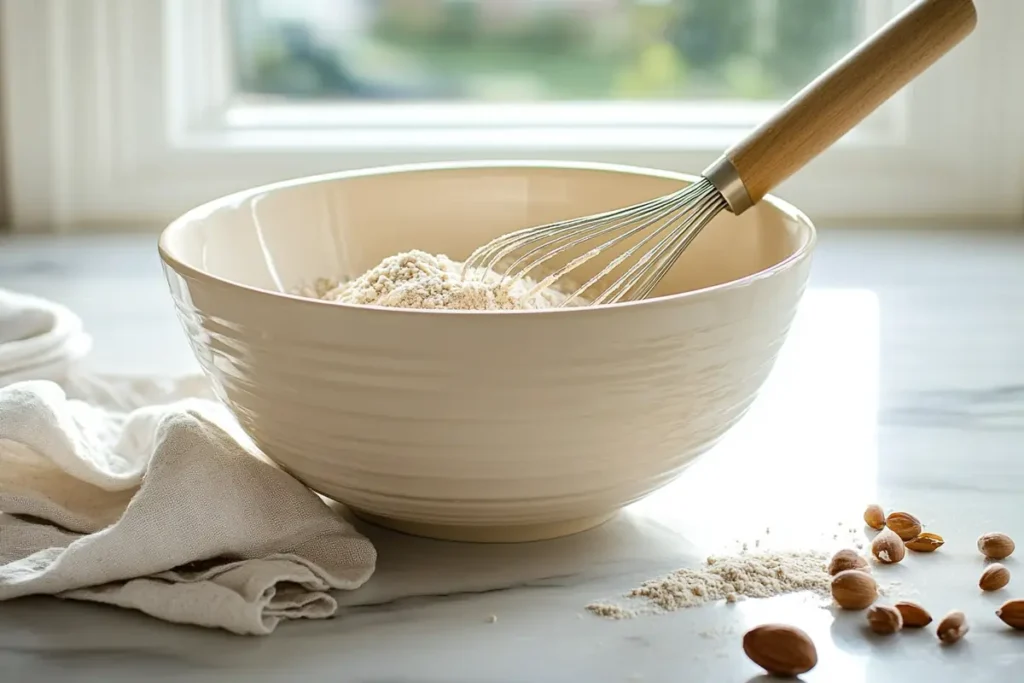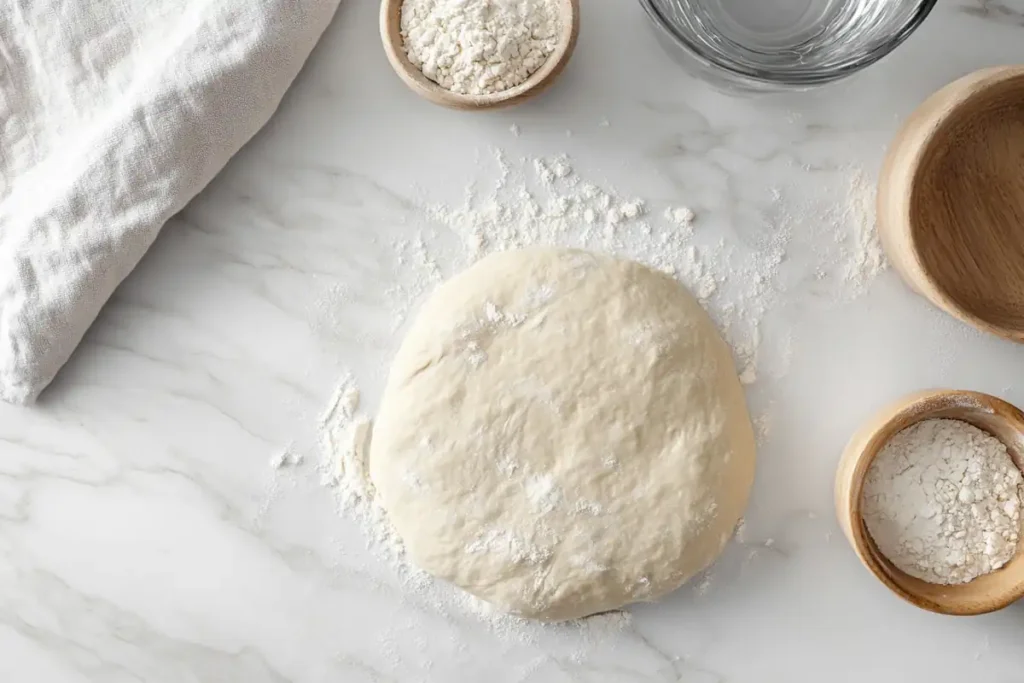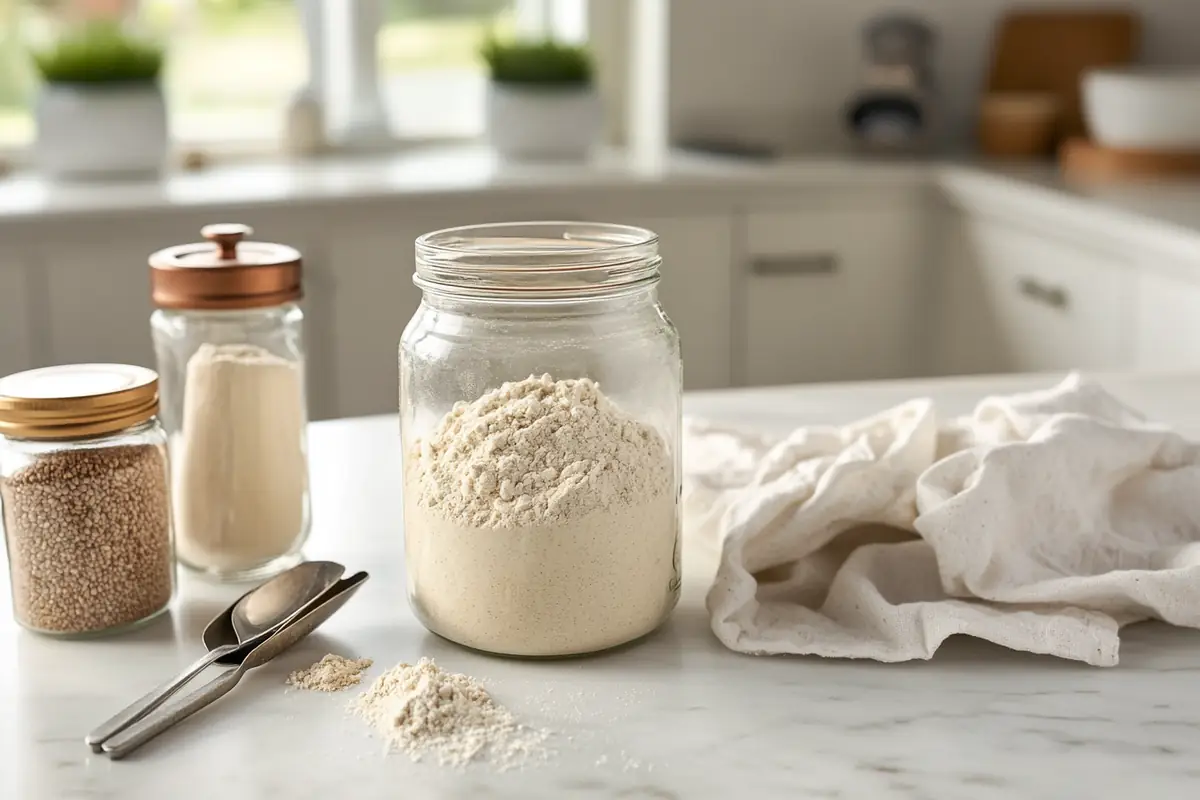When it comes to baking, knowing how to substitute whole wheat flour for all-purpose flour can transform recipes into healthier versions. However, this swap isn’t as straightforward as it seems. Whole wheat flour has a denser texture, richer flavor, and different moisture absorption, making it essential to adjust recipes accordingly. This guide covers everything you need to know about using whole wheat flour in place of all-purpose flour, including baking tips, texture adjustments, and substitution ratios.
Understanding Flour Substitution: Whole Wheat vs. All-Purpose
What Does Flour Substitution Mean?
Flour substitution involves replacing one type of flour with another while maintaining a recipe’s integrity. Switching all-purpose flour with whole wheat flour can change the structure, taste, and appearance of baked goods, requiring specific adjustments.
Why Consider Substituting Whole Wheat Flour?
Whole wheat flour is a healthier alternative due to its higher fiber and nutrient content. It includes the entire wheat kernel, making it a more wholesome choice. Substituting it can enhance the nutritional value of breads, muffins, and pancakes while introducing a nutty flavor.
Challenges When Substituting Flour
Replacing all-purpose flour with whole wheat flour isn’t without hurdles. Its coarser texture can produce denser results, and its ability to absorb more liquid can lead to dry baked goods if not compensated with extra moisture or fat.
Best Recipes for Whole Wheat Flour Substitution
Certain recipes are more forgiving when using whole wheat flour. Yeast-based breads, hearty muffins, and cookies work well because they can handle the flour’s denser texture. Delicate cakes or pastries may require partial substitution for best results.
Differences Between Whole Wheat and All-Purpose Flour
Nutritional Comparison
Whole wheat flour and all-purpose flour differ significantly in their nutritional content. Whole wheat flour contains the entire wheat kernel, including the bran, germ, and endosperm, making it rich in fiber, vitamins, and minerals. In contrast, all-purpose flour is refined, removing the bran and germ, which strips away much of its nutritional value.
- Fiber Content: Whole wheat flour boasts about three times more fiber than all-purpose flour, supporting digestive health and promoting satiety.
- Vitamins and Minerals: It’s packed with essential nutrients like B vitamins, magnesium, and iron, while all-purpose flour is often enriched artificially.
- Caloric Differences: Whole wheat flour has slightly fewer calories per cup due to its higher fiber content, though the difference is minimal.
Texture and Flavor Profiles
The textures and flavors of these flours can drastically alter baked goods.
- Texture Effects: Whole wheat flour has a coarser texture because of its bran content, making baked goods denser and heavier. All-purpose flour, with its fine consistency, yields lighter, fluffier results.
- Flavor Profile: Whole wheat flour imparts a nutty, earthy flavor, enhancing recipes like hearty breads and muffins. All-purpose flour has a neutral taste, making it more versatile in both sweet and savory recipes.
Gluten Content and Its Effects
Gluten plays a crucial role in baking, affecting dough elasticity and rising potential.
- Gluten Levels: Whole wheat flour has slightly less gluten-forming potential because the bran interferes with gluten development. All-purpose flour, being more refined, contains more accessible gluten.
- Dough Elasticity and Rise: Dough made with whole wheat flour tends to be denser and less elastic. It rises slower, often producing a chewier texture unless properly hydrated or supplemented with vital wheat gluten.
Substituting Whole Wheat Flour for All-Purpose Flour
General Substitution Guidelines
Replacing all-purpose flour with whole wheat flour requires strategic adjustments for the best baking results.
- Recommended Substitution Ratios:
Substitute up to 50% of all-purpose flour with whole wheat flour to maintain lightness. For 100% substitution, be ready for denser results. In cookies and muffins, a 1:1 swap often works well if extra liquid is added. - Adjusting Liquid Content:
Since whole wheat flour absorbs more moisture, increase the liquid in your recipe by 2-3 tablespoons per cup of flour. Ingredients like yogurt, applesauce, or mashed bananas also add moisture while enhancing flavor.
Impact on Baking Time and Temperature
Substituting whole wheat flour affects both baking time and temperature:
- Baking Time Adjustments:
Baked goods with whole wheat flour often require 5-10 additional minutes in the oven due to slower moisture evaporation. Monitor closely to avoid over-baking. - Temperature Considerations:
Lower the oven temperature by 25°F for recipes like cakes and pastries to prevent over-browning. This adjustment helps balance slower rising times with more even cooking.
Best Practices for Successful Substitution
Follow these expert tips for perfecting your whole wheat flour recipes:
- Mixing Flours:
Combine whole wheat and all-purpose flours for a balanced texture, especially in cakes or pastries. A 50/50 blend is a great starting point. - Allowing Dough to Rest:
Let the dough rest for 20-30 minutes before baking. This hydration process softens the bran and improves texture. - Using Vital Wheat Gluten:
Add 1 tablespoon of vital wheat gluten per cup of whole wheat flour for better elasticity and structure, particularly in yeast-based breads and pizza dough.
These techniques ensure better rising, texture, and overall baking success when using whole wheat flour.

Recipe-Specific Considerations
Breads and Yeast-Based Recipes
Baking breads with whole wheat flour requires thoughtful adjustments due to its density and lower gluten-forming potential.
- Texture and Rise: Whole wheat flour produces denser breads because the bran and germ disrupt gluten formation. Expect a heartier, more rustic texture.
- Tips for Optimal Results: Use a mix of whole wheat and all-purpose flour for better structure. Adding a tablespoon of vital wheat gluten can boost elasticity, while longer proofing times help with rising. Increasing hydration by 2-3 tablespoons per cup of flour prevents dryness.
Cakes and Pastries
Cakes and pastries present unique challenges when using whole wheat flour due to its heavier consistency and pronounced taste.
- Challenges: Whole wheat flour can make cakes and pastries dry, crumbly, and overly dense. Its nutty flavor may overpower delicate desserts like sponge cakes or puff pastries.
- Strategies: Use whole wheat pastry flour for lighter results. Alternatively, substitute only 25%-50% of the all-purpose flour. Increase the amount of sugar or vanilla extract to balance the strong flavor. Sifting the flour twice also helps with aeration.
Cookies and Quick Breads
Whole wheat flour shines in cookies and quick breads thanks to its ability to add depth of flavor and chewiness.
- Density and Chewiness: Whole wheat flour increases the density of cookies and quick breads, creating a more satisfying bite.
- Balancing Flavors: Use mix-ins like chocolate chips, nuts, or dried fruits to enhance sweetness and texture. Consider adding an extra egg yolk or tablespoon of fat for a richer mouthfeel.
Health Implications and Dietary Considerations
Health Benefits of Whole Wheat Flour
Whole wheat flour is a nutritional powerhouse offering various health benefits:
- Weight Management: Its high fiber content promotes fullness, reducing overeating.
- Blood Sugar Control: Whole wheat flour slows digestion, causing a gradual rise in blood sugar levels, which benefits people managing diabetes.
- Digestive Health: Fiber aids in digestion, relieving constipation and promoting gut health.
Potential Drawbacks and Allergies
Despite its benefits, whole wheat flour may not be suitable for everyone.
- Gluten Sensitivity: People with gluten intolerance or celiac disease should avoid it unless labeled gluten-free.
- Digestive Discomfort: Its high fiber content may cause bloating or gas in sensitive individuals. Gradual dietary adjustments can help mitigate these effects.
Making Informed Choices in Baking
Selecting the right flour depends on your recipe, health goals, and taste preferences.
Personal Preferences: Some people prefer its robust taste, while others might enjoy a milder, less noticeable flour blend. Balancing health and flavor is key to successful baking.
Recipe Suitability: Consider whether a recipe can tolerate whole wheat flour’s density and flavor.
Frequently Asked Questions
What is the best substitute for all-purpose flour?
The best substitutes for all-purpose flour depend on the recipe. Whole wheat flour is a nutritious alternative, especially for bread and muffins. For lighter baked goods like cakes and pastries, consider using whole wheat pastry flour or a blend of whole wheat and all-purpose flours. Other viable options include almond flour, oat flour, and spelt flour, though these may require specific adjustments due to differences in protein and moisture content.
How do I substitute whole wheat flour for all-purpose flour?
To substitute whole wheat flour for all-purpose flour, replace up to 50% of the flour to maintain texture and lightness. If you prefer a full substitution, expect a denser, heartier result. Increase the liquid in the recipe by 2-3 tablespoons per cup of flour, as whole wheat flour absorbs more moisture. Adding a tablespoon of vital wheat gluten can also improve structure in yeast-based recipes.
How do you adjust when baking with whole wheat flour?
Adjustments are crucial when baking with whole wheat flour.
- Increase Liquid: Add extra liquid (water, milk, or juice) to compensate for the flour’s high absorption rate.
- Extend Resting Time: Allow the batter or dough to rest for 20-30 minutes before baking to hydrate the flour fully.
- Add Moisture-Rich Ingredients: Use ingredients like yogurt, applesauce, or mashed bananas to enhance moisture and prevent dryness.
Does whole wheat flour work the same as regular flour?
Not exactly. Whole wheat flour behaves differently due to its coarse texture and high fiber content. It results in denser baked goods and requires extra hydration and longer rising times. While all-purpose flour is versatile and light, whole wheat flour excels in recipes that benefit from a robust flavor and hearty texture, such as bread, muffins, and cookies.
Advanced Baking Techniques with Whole Wheat Flour
Mastering Dough Hydration

Dough hydration is critical when using whole wheat flour. Its bran and germ absorb more water than all-purpose flour, requiring adjustments:
- Measure Precisely: Use a digital scale for accuracy.
- Increase Liquid Gradually: Add water or milk slowly until the dough reaches a smooth, pliable consistency.
- Rest for Full Absorption: Allow the dough to rest for 20-30 minutes before kneading to maximize hydration.
Using Preferments and Starters
Preferments improve flavor, rise, and shelf life when baking with whole wheat flour:
- Types of Preferments: Consider using a sponge, biga, or poolish for extra flavor complexity.
- Fermentation Benefits: Long fermentation reduces bitterness from the bran while enhancing dough elasticity and rise.
Storing and Handling Whole Wheat Flour
Proper Storage Tips
Whole wheat flour has a shorter shelf life due to its natural oils, which can go rancid:
- Airtight Containers: Use sealed containers to prevent moisture and air exposure.
- Cool, Dark Location: Store flour in a cool, dark pantry or refrigerator to extend its freshness.
- Freezing Option: For long-term storage, freeze whole wheat flour in sealed bags for up to six months.
How to Tell If Whole Wheat Flour Has Gone Bad
Expired whole wheat flour can spoil due to oil oxidation. Watch for these signs:
- Off Odor: A sour, musty, or stale smell indicates spoilage.
- Discoloration: Fresh whole wheat flour is light brown; darkening may signal rancidity.
- Taste Test: If the flour tastes bitter, it’s past its prime and should be discarded.
Creative Whole Wheat Flour Recipes
Healthy Breakfast Ideas
- Whole Wheat Pancakes: Fluffy and filling, perfect with fruit toppings.
- Breakfast Muffins: Add nuts, seeds, and dried fruits for extra nutrition.
Savory Options for Dinner
- Whole Wheat Pizza Dough: Crispy and hearty, pairs well with bold toppings.
- Whole Wheat Tortillas: Great for tacos and wraps, with a rustic texture.
Sweet Treats for Dessert
- Whole Wheat Banana Bread: Moist, delicious, and naturally sweet.
- Whole Wheat Chocolate Chip Cookies: A chewy, nutty twist on the classic favorite.
Conclusion
Substituting whole wheat flour for all-purpose flour is a smart choice for boosting the nutritional value of baked goods. While whole wheat flour’s dense texture and nutty flavor require recipe adjustments, the health benefits—such as increased fiber, vitamins, and minerals—are worth the effort. Balancing flour ratios, adding extra liquid, and using complementary ingredients can enhance the final product’s taste and texture.
Baking is as much an art as it is a science, so don’t hesitate to experiment. Start by replacing half of the all-purpose flour in your favorite recipes, then gradually increase the ratio as you become more comfortable. Remember, each recipe may respond differently, but with practice, you’ll master the technique and enjoy healthier, heartier treats. So, grab that bag of whole wheat flour and let your baking adventures begin!

